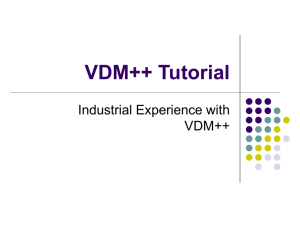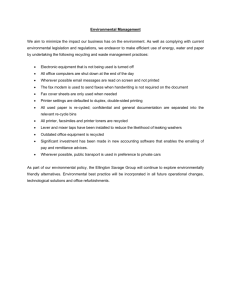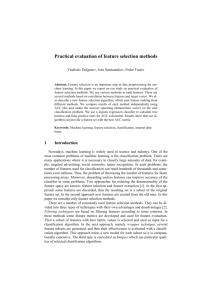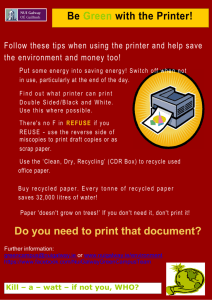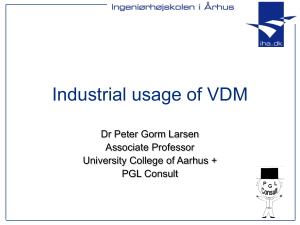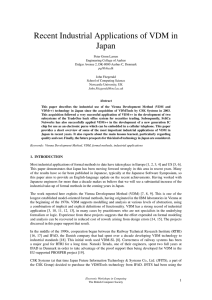Modelling and Analysis of Distributed Embedded Real
advertisement
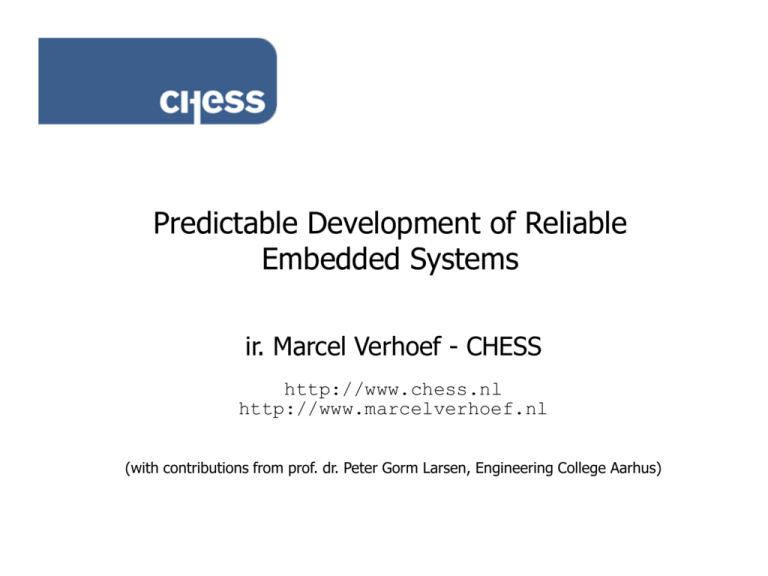
Predictable Development of Reliable
Embedded Systems
ir. Marcel Verhoef - CHESS
http://www.chess.nl
http://www.marcelverhoef.nl
(with contributions from prof. dr. Peter Gorm Larsen, Engineering College Aarhus)
Agenda - “Back to the Future”
• Introduction and Background
• Using VDM++ and VDMTools: theory and practice
• In the past : successful projects in industry
• In the present : architecture and deployment
• In the future : continuous time co-simulation
• Conclusions
Who Is Marcel Verhoef?
Predictable Development?
Software Project Characteristics
1995
Cancelled before delivery
31 %
Exceeds time scale & cost, reduced functionality
53 %
On time and budget
16 %
Mean time overrun
190 %
Mean cost overrun
222 %
Mean functionality delivered
60 %
• Source: The Chaos Report (http://www.standishgroup.com)
Predictable Development?
Software Project Characteristics
1995
2004
Cancelled before delivery
31 %
18 %
Exceeds time scale & cost, reduced functionality
53 %
53 %
On time and budget
16 %
29 %
Mean time overrun
190 %
84 %
Mean cost overrun
222 %
56 %
Mean functionality delivered
60 %
64 %
• Source: Jim Johnson, “My Life Is Failure”, ISBN 1-4243-0841-0
Reliable Systems?
Reliable Systems?
Uptime: 125 years
Source: Tom Henzinger, FM 2006 invited talk
The problem : dealing with complexity
• System complexity is increasing continuously
• We choose to put that complexity in software
• More and more software becomes business critical
• More and more software becomes safety critical
The problem : dealing with complexity
400 horses 100 CPUs
Software Development Engineering
• Engineering is conservative
–
–
–
–
application of science
embedded within mature processes
with effective quality and risk management
to build practical systems cost-effectively
• Software development is opportunistic
– ruled by fashion (platform, languages, methodologies)
– usually not well organised, error-prone and lacking discipline
– very hard to predict (both quality and quantity)
Successful engineering approaches
•
Build system models to gain
confidence in requirements and
designs
•
use
–
–
–
–
of abstraction
well-focused
problem-oriented
unambiguous
precise
•
use
–
–
–
–
of rigour
objective
repeatable
exploration
analysis
An Approach To Modelling Computing Systems
• Vienna Development Method (VDM)
– Invented at IBM research laboratory in Vienna in the 70’s
• VDM-SL (specification language, ISO/IEC 13817-1:1996)
• VDM++ (object-oriented extension)
– model-oriented language with formal syntax and semantics
•
•
•
•
simple and abstract data types (sets, sequences, maps,...)
uses invariants to restrict type membership
implicit specification (using pre- and post conditions)
explicit specification (functional or imperative)
– referential transparent functions
– operations with side effects on state variables
VDM-SL module structure
module <module-name>
parameters
imports
instantiations
Interface
exports
...
definitions
state
types
values
functions
operations
...
end <module-name>
Definitions
VDM++ class structure
class <class-name>
instance variables
...
Internal object state
types
values
functions
Definitions
operations
...
thread
...
Dynamic behaviour
sync
...
end <class-name>
Synchronization control
Tool support for VDM
Syntax & Type Checker
Java to VDM++
Integrity Checker
The Rose-VDM++ Link
Interpreter (Debugger)
Document Generator
API (Corba), DL Facility
Code Generators
- C++, Java
The Past
Using VDMTools In The Commercial Enterprise
(1998 - 2002)
Dutch Government - Department of Defense (1)
• information management system
• mission-critical system component
• coupling to very large database
• 2 man-year development effort
• 98% VDM-SL (400 pages ± 15 kloc)
• ± 90 kloc C++ (code generation)
• delivered on-time and within budget
• no errors found after release
• still in use today
• return on investment : within project
Dutch Government - Department of Defense (2)
Flower Auction at Aalsmeer (1)
• largest covered market place
in the world (1.000.000 m2)
• spot market for fresh cut
flowers and plants
• 13 auction clocks in 4 halls
• world market share 45%
• Kenia, Israel, Ethiopia
Aalsmeer Germany, Japan
• 44000 transactions per day
• 6.9 M Euro turnover per day
• obviously mission critical
1.0 e6 m2 200 football fields
Flower Auction at Aalsmeer (2)
• “Dutch auctioning” process
• up : 60 Hz down : 30 Hz
• transaction : 5 seconds max
• new : on-line participation
• many challenges
– unknown application area
– use novel technology
– unclear requirements
– inexperienced team
– no development process
• used VDM++ and UML
• completed successfully
The Present
Enhancing VDMTools For Embedded Systems
joint work with Peter Gorm Larsen and Jozef Hooman
[ LNCS 4085, FM 2006, pp 147-162 ]
Enhancing VDMTools For Embedded Systems
• Motivation: early life-cycle system architecting
• VDM++ for distributed embedded real-time
• Case Study : In-Car Radio Navigation System
early life-cycle system architecting (1)
• design paradox : “shooting at a moving target”
– volatile requirements & many unknowns (not just technical)
– nevertheless key architecture decisions must be made
• additional complications
– business case always evolves over time
– out-of-phase development usually occurs, for example
mechanics electronics software
– technology evolves much faster than project elapse time
early life-cycle system architecting (2)
• key problems
– system-level overview is usually lacking (dominating view)
– methods do not sufficiently support design iteration
(building models takes too much time and effort)
• the proposed solution
– notational extensions for context aware software models
(explicit notion of architecture and deployment)
– improve tool support for early model validation
(enhanced visualisation)
VDM++ for distributed embedded real-time
• old VDMTools VICE version 6.6
–
–
–
–
all software implicitly deployed on a single CPU
only synchronous operation calls are allowed
only absolute notion of time (duration)
only strict periodic behaviour can be specified
• new VDMTools VICE version 8.0
–
–
–
–
–
hardware architecture can be described using BUS and CPU
explicit deployment of software (class instances) on CPUs
support for synchronous and asynchronous operation calls
absolute and relative notion of time (duration and cycles)
elaborate periodic behaviour (period, jitter or burst, offset)
Example: In-Car Radio Navigation System
• car radio with built-in navigation system
• several applications may execute concurrently
• user-interface needs to be responsive at all times
• traffic messages must be processed on time
• what is a suitable architecture for this product?
“Change Volume” application
“Handle TMC” application
Proposed Architecture Alternatives
Absolute and relative elapse time
class Radio
operations
async public AdjustVolume: nat ==> ()
AdjustVolume (pno) ==
( duration (150) skip;
RadNavSys`mmi.UpdateVolume(pno) );
async public HandleTMC: nat ==> ()
HandleTMC (pno) ==
( cycles (10000) skip;
RadNavSys`navigation.DecodeTMC(pno) )
end Radio
Absolute and relative elapse time
class Radio
operations
async public AdjustVolume: nat ==> ()
AdjustVolume (pno) ==
( duration (150) skip;
RadNavSys`mmi.UpdateVolume(pno) );
async public HandleTMC: nat ==> ()
HandleTMC (pno) ==
( cycles (10000) skip;
RadNavSys`navigation.DecodeTMC(pno) )
end Radio
Specifying the hardware architecture (1)
system RadNavSys
instance variables
-- create the
static public
static public
static public
class instances
mmi := new MMI();
radio := new Radio();
navigation := new Navigation();
Specifying the hardware architecture (2)
...
-- create the
CPU1 : CPU :=
CPU2 : CPU :=
CPU3 : CPU :=
computation resources
new CPU(<FP>, 22E6, 0);
new CPU(<FP>, 11E6, 0);
new CPU(<FP>, 113E6, 0);
-- create the communication resource
BUS1 : BUS := new BUS(<FCFS>, 72E3, 0,
{CPU1, CPU2, CPU3})
Specifying the hardware architecture (3)
...
operations
public RadNavSys: () ==> RadNavSys
RadNavSys () ==
( CPU1.deploy(mmi);
CPU2.deploy(radio);
CPU3.deploy(navigation) )
end RadNavSys
Modeling the environment of the system
class TransmitTMC
...
operations
async createSignal: () ==> ()
createSignal () ==
( dcl num : nat := getNum();
e2s := e2s munion {num |-> time};
RadNavSys`radio.HandleTMC(num) );
async public handleEvent: nat ==> ()
handleEvent (pev) == s2e := s2e munion {pev |-> time}
post forall idx in set dom s2e &
s2e(idx) – e2s(idx) <= 1000
thread
periodic (3000, 4500, 1000, 0) (createSignal)
end TransmitTMC
In-Car Radio Navigation System Overview
Visualisation - ShowTrace “system view”
Visualisation - ShowTrace “resource view”
Enhanced Modelling Support - Summary
• Simple and intuitive language extensions
• Significant improvement expressiveness
• Much better domain applicability
• Significant decrease in model size
• “backward compatible” semantics
• Exploration of deployment and performance feasible
• Early detection of design bottlenecks by visualization
The Future
Embedding VDMTools Into System Engineering
joint work with Peter Visser, Jozef Hooman and Jan Broenink
[ LNCS 4591, IFM 2007, pp 639-658 ]
Embedding VDM++ Into System Engineering
• Motivation : multi-disciplinary system-level design
• Showdown : Continuous Time meets Discrete Event
• Case Study I : water tank level controller
• Case Study II : printer paper path controller
Beyond the Ordinary: Design of Embedded Real-time Control
•
BODERC project @ ESI
•
Sept 2002 - Apr 2007
•
Multi-disciplinary design
– mechanics
– electronics
– software
•
High-tech systems focus
•
Early life cycle trade-off analysis
•
Industry as a laboratory
•
http://www.esi.nl/boderc
Design of High-Tech Systems - State of Practice
STRONG TENSION
system
integration
and test
software
electronics
mechanics
PROJECT ELAPSE TIME
requirements
•
design is typically mono-disciplinary
organised
•
domain specific methods
and custom tools are used
•
out-of-phase development and
system-level focus lacking
•
cross-cutting concerns postponed to
the integration phase
•
late validation & feedback
“ INTEGRATION HELL ”
Multi-disciplinary Systems Design - The Vision
requirements
test & integration
WEAK TENSION
software
electronics
mechanics
PROJECT ELAPSE TIME
integrated models
•
system level approach
•
model-driven design
•
integrated models & tools
•
rapid evaluation
•
early feedback
•
support design dialogue
•
continuous integration
•
continuous validation
•
less effort overall
•
higher quality
The Challenge - Integrated Design Models (1)
• Notations and analysis techniques used by the
disciplines are fundamentally different
– mechanics : finite element methods
– electronics : differential or difference equations
– software : labelled transition systems
• Is a common notation feasible* at all?
*
[Henzinger & Sifakis, FM 2006 key note, LNCS 4085, pp 1-15]
The Challenge - Integrated Design Models (2)
• scope of discipline specific tools is widening
– Matlab Simulink Stateflow, Real-Time Workshop, TrueTime
– Rhapsody Simulink
– UML SysML
• bigger piece of the pie satisfy all stakeholders (disciplines)
• problems : poor abstraction, restrictive model of computation
• novel actor-based techniques* : Ptolemy-II
• problems : disruptive approach, weak semantics
* [ http://ptolemy.eecs.berkeley.edu ]
Our Approach - Integrated Design Models (3)
• Cross the continuous time - discrete event divide
• Select a well-defined (formal) notation on either side
• Explore semantic integration of those notations
• Implement tool support for this reconciled semantics
• Analyse combined models by (reliable) co-simulation
Expected benefits - Integrated Design Models (4)
• good abstraction facilities on both sides of the divide
• supports light-weight modelling required in early stages
• few Model of Computation (MoC) specific restrictions
avoid a-priori design bias
• fits in design flow
low threshold for industrial uptake
• inspired by previous experience (INFORMA EU project)
weak coupling between VDMTools and Simulink
Continuous Time Realm - Bond Graphs
•
dynamic systems modelling,
physics domain independent
– mechanics
– electronics
– pneumatics
•
graphical notation: Bond graphs*
•
formal analysis for algebraic
loops and differential causalities
•
model validation through
simulation and visualisation
•
industry grade tool support
http://www.20sim.com
* [ Gawthrop, Bevan, IEEE Control Systems
Magazine, April 2007, pp 24 - 45 ]
Continuous Time Realm - Informal Semantics
• sets of differential equations
• approximate solution(s) numerically by
• discrete integration over some time interval
• many “solver” algorithms available e.g. Euler
• CT shares state variables with DE model
• capture state events : zero-crossing detection
• capture time events : proceed to time t > now
Our Approach by Example - Water Tank Level Controller
level
Co-Simulation - Sharing State Variables
“ACTUATOR”
VALVE
DE
lwm hwm
LEVEL
CT
“INTERRUPTS”
“SENSOR”
Co-Simulation - State and Time Events
var = p(t)
p
REE (var, p)
FEE (var, p)
t
TE (t)
lwm = FEE (level, 2.0)
hwm = REE (level, 3.0)
Our Approach by Example - water tank case (2)
Our Approach by Example - water tank case (3)
Our Approach by Example - water tank case (4)
Printer paper path - case study (1)
Printer paper path - case study (2)
VDM++
Bond
graphs
VDM++
VDMTools
co-sim
results
20-sim
VDMTools
C++
HOST
COMPILER
Bond
graphs
VDM++
VDMTools
C++
TARGET
COMPILER
continuous
validation
DLL
20-sim
SIL sim
results
ctrl app
measurements
Printer paper path - case study (3)
FeedSheet
PaperDetectors
BeltDisturbance and Gear
PaperPower
PWM
K
DC
H_Bridge
Motor
Pinch
InternalMotorVelocity
V
0
MotorVelocity
FrictionModel
K
Rad2Rev
q
Driving
Animation
Coupling
ElectricalInductance
Driven
InertiaMotorAxis
I
Pinch1
Pinch2
Pinch3
I
Pinch4
electricity
MSe
1
GY
1
rotation
MotorConstant
R
R
ElectricalResistance
PWM
CoulombFriction
Rot2Trans_Paper
ENC
p_trans
p_rot
J
ViscousFriction CoulombFriction PichInertia
Printer paper path - case study (4)
Supervisor
init()
pimUpEvent()
fuseUpEvent()
Supervisor()
pimDownEvent()
corrDownEvent()
alignDownEvent()
setPimSeqCtrl()
setCorrSeqCtrl()
setFuseSeqCtrl()
setAlignSeqCtrl()
setEjectSeqCtrl()
-ejectSeqCtrl 0..1
-alignSeqCtrl 0..1
-fuseSeqCtrl 0..1
-corrSeqCtrl 0..1
-pimSeqCtrl 0..1
PidController
SequenceController
initIdle()
initPeak()
initNominal()
setStopProfile()
setBeginAtProfile()
makeAccProfile()
makeDistanceProfile()
setLoopController()
-loopctrl
0..1
getEnc()
limit()
CtrlLoop()
calcPID()
getSetpoint()
setPwm()
setUpPID()
PidController()
getIntegratedSetpoint()
addProfileElement()
SetpointProfile
-profile
getSetpoint()
addElement()
getIntegratedSetpoint()
calcSetpoint()
calcIntegratedSetpoint()
Printer paper path - case study (5)
Printer paper path - case study (6)
Printer paper path - case study (7)
Printer paper path - case study (8)
VDM++ In System Engineering - Summary
• Promising academic research results
–
–
–
–
–
–
coupling does not restrict tools or add complexity
co-simulation enables cross discipline design dialogue
small models due to powerful CT and DE abstraction
low effort design evaluation
discipline specific analysis on models is still possible
light-weight modelling can provide accurate answers
• generic integrated operational semantics
• (vendor) independent of continuous time simulator
• caveat : not yet available in VDMTools
Conclusions (1)
• VDM++ very suitable for managing complexity
• Applicable to embedded systems domain
• Not disruptive to current design practices
• Level of rigour can be chosen depending on task
• Improves quality of design dialogue dramatically
• Consistent documentation reduces maintenance cost
Conclusions (2)
• VDM++ and VDMTools help the system architect to
–
–
–
–
increase confidence in the design
to reduce project and product risks
while dealing with uncertainty
while working under high time pressure
• the system architect is empowered to
– bridge the gap between the engineering disciplines
– deal with design complexity in a cost-effective way
Back To The Future? The Future is Now!
Thank You for Your Attention
http://www.marcelverhoef.nl
http://www.vdmtools.jp/en
Questions?
